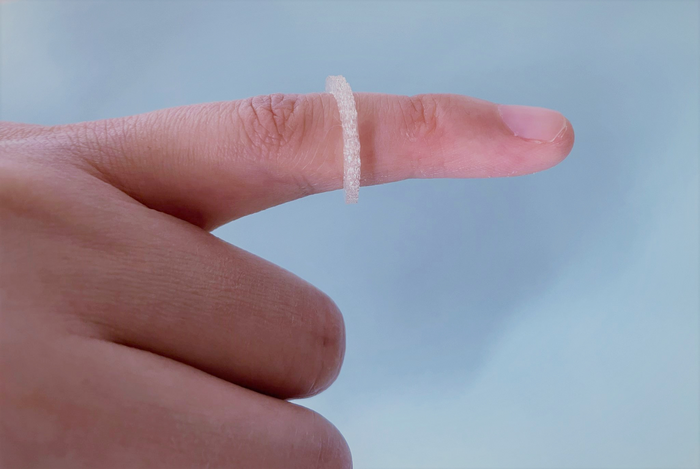Scientists create the first-ever printable, wearable insect repellent
A new type of insect-repellent delivery device has been developed by scientists from the Martin Luther University Halle-Wittenberg (MLU)

[Oct 23, 2022: Tom Leonhardt, Martin Luther University Halle-Wittenberg]
This is what the ring looks like that could help repel insects. (CREDIT: Uni Halle / Fanfan Du)
A new type of insect-repellent delivery device has been developed by scientists from the Martin Luther University Halle-Wittenberg (MLU). With the help of a 3D printer, the active ingredient is first "encapsulated" and formed into the desired shape, such as a ring, which can then be worn and releases an agent designed to repel mosquitoes for a long time.
The team has presented its work in the International Journal of Pharmaceutics. The researchers have developed their prototypes using "IR3535", an insect repellent developed by MERCK.
"Mosquito sprays containing IR3535 are very gentle on the skin and have been used all over the world for many years. That’s why we’ve been using the agent for our experiments", says Professor René Androsch from the MLU.
It is usually applied as a spray or lotion and offers several hours of protection. However, Androsch and his team are looking for ways to release the agent over a much longer period, such as by encapsulating it in a wearable ring or bracelet.
Related News
The researchers have succeeded in using a special 3D printing technique to insert the insect repellent into a biodegradable polymer in a controlled manner and to shape the mixture of substances in various ways. "The basic idea is that the insect repellent continuously evaporates and forms a barrier for insects", explains the lead author of the study, Fanfan Du, a doctoral candidate at the MLU.
The polymer/repellent system PLLA/IR3535 can be 3D-printed to obtain a drug-delivery device. (CREDIT: International Journal of Pharmaceutics)
The rate at which the insect repellent evaporates depends on many different factors, including temperature, concentration and the structure of the polymer used. After conducting various experiments and simulations, the team predicts that the insect repellent needs well over a week to evaporate completely at a temperature of 37°C (98,6 °F, i.e., body temperature).
Technavio has announced its latest market research report titled Insect Repellent Market by Product and Geography - Forecast and Analysis 2022-2026
While the researchers have proven that it is absolutely possible to develop a wearable insect repellent, the rings and other forms created for the study are only prototypes.
According to Androsch, further research needs to be carried out to determine how well the rings function under actual conditions. The encapsulation material could also be further optimised.
The work was funded by the Deutsche Forschungsgemeinschaft (DFG, German Research Foundation) and within the framework of the graduate school "AGRIPOLY" at MLU. "AGRIPOLY" is funded by the European Social Fund (ESF) and the state of Saxony-Anhalt.
Study: Du F., et al. 3D-printing of the polymer/insect-repellent system poly(l-lactic acid)/ethyl butylacetylaminopropionate (PLLA/IR3535). International Journal of Pharmaceutics (2022).
Note: Materials provided above by the Martin Luther University Halle-Wittenberg. Content may be edited for style and length.
Like these kind of feel good stories? Get the Brighter Side of News' newsletter.
Joseph Shavit
Head Science News Writer | Communicating Innovation & Discovery
Based in Los Angeles, Joseph Shavit is an accomplished science journalist, head science news writer and co-founder at The Brighter Side of News, where he translates cutting-edge discoveries into compelling stories for a broad audience. With a strong background spanning science, business, product management, media leadership, and entrepreneurship, Joseph brings a unique perspective to science communication. His expertise allows him to uncover the intersection of technological advancements and market potential, shedding light on how groundbreaking research evolves into transformative products and industries.



